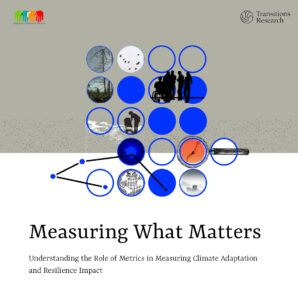India’s energy landscape is in a state of flux. With bold targets to diversify its energy mix, reach 500 GW of renewable energy capacity by 2030, India has embarked on a process of rapid transition towards green and sustainable energy sources. This transition is also accompanied by calls for a rapid integration of digital technologies and AI in the energy sector.
Recent years have witnessed India make notable progress, with renewable energy capacity rising to over 143.64 GW as of 2024, and substantial investments in solar and wind energy, the path forward, however, is layered with systemic and legacy issues, mounting energy needs of a rapidly urbanising population, and intricate socio-political dynamics. While AI and digital technologies are often seen as catalysts for speeding up energy transitions, are we equipped to meet the complex demands of socio-technological transitions in the energy sector, and ensure equity and inclusion?
At a recent dialogue hosted by Transitions Research, on the question of “Can Digitalisation and AI Accelerate India’s Energy Transition?” panellists from various fields came together to delve into these complexities. The conversation highlighted not just the potential of AI, but also the diverse contexts of institutional, social, and political factors that will ultimately determine its impact.
AI’s Role in Energy Transition: Opportunities in Complexity
At the heart of India’s energy transition is the ambitious goal to reduce its carbon footprint and diversify its energy mix. The country aims to achieve net-zero emissions by 2070 and has set interim targets, such as reducing the emissions intensity of its GDP by 45% by 2030. AI is increasingly seen as a critical enabler in this journey, offering tools to optimise energy operations, enhance grid management, and integrate renewable energy sources more effectively.
Priya Donti, co-founder of Climate Change AI, painted a compelling picture of AI’s potential in the energy sector. She outlined how AI can distil large datasets into actionable insights, such as identifying where solar panels are installed or mapping grid infrastructure through satellite imagery. This capability is particularly valuable in regions where on-the-ground data is scarce or outdated. Furthermore, AI-driven forecasting can help energy planners predict consumption patterns, manage grid stability, and schedule power generation with greater precision, especially in a grid increasingly dominated by variable renewable energy sources like solar and wind.
However, Donti also emphasised that AI is not a panacea. While it can enhance short-term forecasting by analysing historical data, its effectiveness diminishes when predicting long-term trends, particularly in rapidly changing environments like India. “AI is a powerful tool, but it’s only as good as the data it works with,” she noted, stressing that AI should complement, rather than replace, other methods such as techno-economic models.
One of the most intriguing points raised during the dialogue was the potential for AI to accelerate the discovery of next-generation clean technologies. By learning from the outcomes of past experiments, AI can suggest which combinations of materials and processes might yield the most efficient batteries or solar cells. This application of AI not only speeds up the innovation process but also reduces the costs associated with trial and error in clean technology development.
Digital Divide and Infrastructure Challenges: The Reality Check
While the potential of AI is undeniable, its implementation within India’s energy and digital transitions is fraught with challenges. The dialogue made it clear that the country’s energy sector faces significant institutional and governance issues that could impede the effective deployment of AI. Simran Grover, CEO of the Center for Energy, Environment, and People, highlighted the declining state capabilities as a critical concern. He pointed out that core functions of energy utilities, such as grid management and billing, are increasingly being outsourced, leading to a loss of institutional knowledge and accountability.
Grover’s remarks on the state of data transparency and standardisation were particularly telling. He described how energy utilities often fail to maintain accurate and up-to-date records, with many data points left blank or inaccurately filled in official reports. This lack of reliable data not only hampers effective energy planning, but also undermines the potential of AI to deliver accurate forecasts and optimise operations.
The Political Economy of Energy and Digital Transitions: A Complex Landscape
India’s energy transition is not just a technical challenge; it is deeply intertwined with the country’s political and economic landscape. The dialogue illuminated the complexities of managing an energy system that is still heavily reliant on coal, even as the country strives to expand its renewable energy capacity. Grover pointed out the challenges of transitioning away from coal-fired power plants, which are deeply embedded in India’s socio-political fabric, particularly in coal-dependent states.
Siddharth Sareen, research professor at the Fridtjof Nansen Institute, Norway delved into the socio-political dimensions of energy transition, emphasising the importance of transparency and accountability in the deployment of AI. He cautioned against viewing AI as a one-size-fits-all solution, warning that without careful implementation, AI could become just another “black box” that obscures rather than clarifies decision-making processes.
Sareen’s insights into the role of AI in monitoring energy systems were particularly illuminating. He suggested that AI could be used to empower citizens by creating crowdsourced platforms for real-time monitoring of power outages and grid performance. Such tools could help hold utilities accountable and ensure that energy access is equitable across different regions. However, he also stressed that these systems must be designed with sensitivity to local contexts, particularly in rural and underserved areas where digital literacy remains low.
The discussion also touched on the role of AI in urban planning and transportation, sectors that are closely linked to both energy and digital transitions. Sareen provided an example from his fieldwork in Rajasthan, where despite the promise of AI-driven solutions, the realities on the ground—such as shortages of critical infrastructure and overwhelmed utility staff—often hinder progress. Sareen’s anecdote about a utility manager in Jaipur, who was too overwhelmed by daily operational issues to even consider long-term AI strategies, highlighted the disconnect between high-level policy ambitions and on-the-ground realities. Emphasising caution, Sareen noted that “we need to be careful about who’s promoting this discourse, for what it’s being promoted and why we’re talking about AI with a level of promissory potential that has been allocated to things like smart metres for a long time also, and that hasn’t really benefited people.”
Navigating the Twin Transitions: A Call for Integrated Approaches
The dialogue underscored the need for a more integrated approach to managing India’s twin transitions. Both energy and digital transformations are critical to the country’s future, but their success will depend on the extent to which they are harmonised and mutually reinforcing. AI has the potential to play a significant role in this process, but only if it is deployed thoughtfully and in conjunction with broader efforts to address governance, infrastructure, and equity challenges.
One of the key takeaways from the event was the importance of collaboration between different sectors and stakeholders. Priya Donti emphasised the need for AI and machine learning experts to work closely with domain specialists in energy, urban planning, and social sciences to ensure that AI solutions are grounded in a deep understanding of local contexts and challenges. Calling for a critical and educated approach to AI, Donti argued, that “care needs to be taken to ensure that people using AI as an assistive technology have enough base understanding of the area of expertise, in order to contextualise whether the information is actually correct, or whether it’s the whole truth as opposed to just part of the truth”.
Simran Grover echoed these sentiments, noting that the success of AI in India’s energy transition will depend on the willingness of policymakers and industry leaders to embrace transparency and accountability. He pointed out that many of the challenges facing the energy sector, such as data accuracy and regulatory compliance, are not technological but institutional. Addressing these issues will require a concerted effort to build capacity within state institutions and to create a regulatory framework that supports innovation while protecting the public interest.
AI as an Enabler, Not a Panacea
The dialogue made it clear that while AI holds significant promise for accelerating India’s energy and digital transitions, it is not a silver bullet. Its success will depend on addressing broader challenges related to governance, equity, and infrastructure, as well as fostering collaboration between different sectors. AI should be seen as an enabler—one tool among many—that, when used correctly, can support a more sustainable and equitable future for India.
As we move forward, it will be crucial to ensure that AI and digital technologies are integrated in ways that benefit all citizens, particularly those in underserved and rural areas. This will require a balanced approach that combines technological innovation with strong governance and a commitment to social justice.




